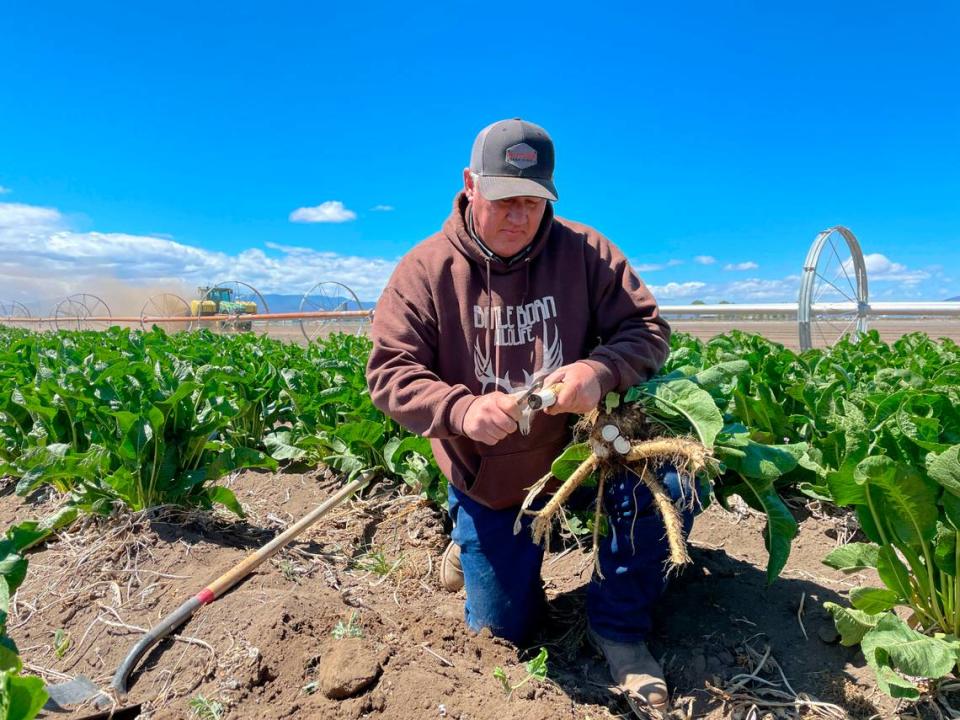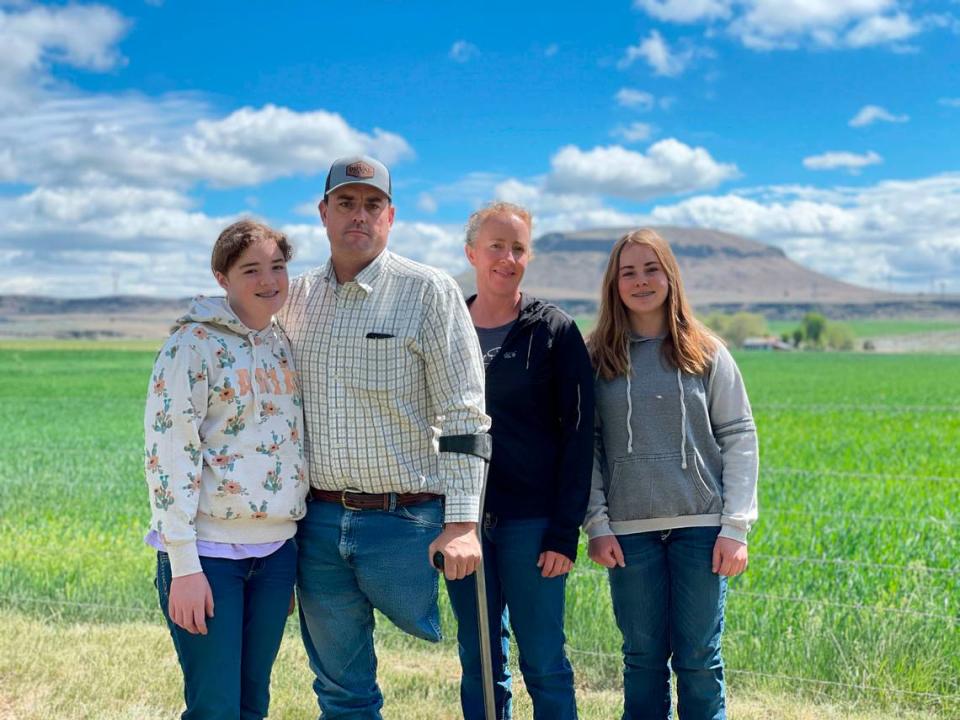‘Ammon Bundy coming soon.’ Federal water cutoffs igniting rebellion in Northern California
- Oops!Something went wrong.Please try again later.
In the summer of 2001, local farmers and other activists armed with saws and blowtorches breached a chain-link fence and opened the headgates of a federal canal that supplies farmland in Oregon and far Northern California.
Local farmer Grant Knoll was among the activists there that year. The protesters forced the gates open three times but were eventually blocked by U.S. marshals. Now, with a drought just as severe as two decades ago — and with farmers’ water again cut off — he’s prepared to fight again.
This spring, he and another farmer, Dan Nielsen, bought the property next to the headgates in Klamath Falls, Ore. They erected a red and white tent surrounded by American flags and protest signs, and they’re holding regular gatherings. And they’re working with a group with close ties to anti-government activist Ammon Bundy.
Knoll was blunt when asked about the possibility of activists storming the headgates this time around.
“I don’t see why not,” Knoll told The Sacramento Bee. “The federal government’s not following the law. They’re breaking the law continuously. And so we’re at a point where, you know, they’re abusing their power. So how do you stop the federal government when they’re abusing their power?”
Handwritten signs outside the tent read “Ammon Bundy coming soon” and “Tell Pharaoh let our water feed the Earth,” according to local media accounts.
The Klamath Basin is 200 miles west of Burns, Ore., where armed right-wing activists, led by Bundy, seized control of a federal wildlife refuge for 41 days in 2016 to protest government land policies.
Twenty years ago, U.S. marshals spent months protecting the headgates of the federal “A Canal” from protesters angry that irrigation water was cut off to protect endangered fish.
Local agricultural leaders worry a similar revolt could attract outsiders like Bundy this summer to the drought-crippled Klamath Basin where anti-government sentiment and frustration over endangered species protection runs high.
“That’s one of my biggest fears,” Ben DuVal, the president of the Klamath Water Users Association, said in an interview last week inside his farmhouse outside Tulelake.
“Because those idiots, they have no business being here. I don’t want them here. … I’d say 95% of us are reasonable, and … we don’t want them to take this crisis in our community and use it as a soapbox to push their agenda. And that’s what they’re looking for. They’re looking for a stage.”
Major drought cripples the Klamath
Dust devils are already dancing through the barren wheat, onion and potato fields that straddle the California-Oregon border. Catastrophe looms for endangered fish and water birds. And for the first time in 114 years, the canal that sends water to 150,000 acres of farms on the federal government’s Klamath Project will stay completely dry this season.

Federal water managers have for years struggled to strike a balance between supplying water for farmers while still leaving enough water in Oregon’s Upper Klamath Lake to keep two species of endangered suckers from going extinct.
Those fish are sacred to the Klamath Tribes, a federally recognized nation made up of the Klamath, Modoc and Yahooskin band of Northern Paiute Indians headquartered in Chiloquin, Ore.
At the same time, the government is supposed to provide blasts of water known as “flushing flows” down the Klamath River in California to try to prevent disease from killing juvenile salmon. Those fish are critical to the livelihoods and cultural identities of three of California’s largest Native American tribes, the Yurok, Karuk and the Hoopa Valley.
The government said there wasn’t enough water for the flushes this spring, and the salmon-dependent tribes say the salmon are already dying in the lower Klamath River. The Klamath Tribes around Upper Klamath Lake say its levels are at the bare minimum needed to keep the suckers alive, and they too fear a die-off.
Farmers were told May 12 what little water they received from the Klamath Project this spring was all they were going to get for the remainder of the year. The “A Canal” would stay dry for the first time since it was constructed in 1907.
Farmers use Klamath Project water to grow alfalfa, potatoes, horseradish, beets, onions, garlic and wheat.
In an announcement, the Klamath Water Users Association called it the “Worst Day in the History of the Klamath Project.” And not just for the farmers.
Two of California’s major wildlife refuges that rely on the project — Tule Lake and Lower Klamath, all that’s left of large natural lakes drained for farming — might go completely dry this year, depriving millions of migratory birds of a vital stopover.
“This year’s drought conditions are bringing unprecedented hardship to the communities of the Klamath Basin,” Camille Calimlim Touton, a deputy commissioner with the U.S. Bureau of Reclamation, said in a written statement on May 12 announcing the cutbacks.
After 10,000 activists from around the U.S. in 2001 converged on the region to hold symbolic “bucket brigade” protests, the Bush administration eventually sent more water to farms, a move the downriver tribes blamed for thousands of adult salmon dying in the low river flows.
This time around, the spring and winter brought so little water, there’s no relief coming for anyone, said Frankie Myers, the vice chairman of the Yurok Tribe.
“No one’s winning anywhere,” he said in an interview earlier this month alongside the Klamath River. “I think that knee-jerk reaction for humans across the board is to point your finger and blame some other community, or take some other action.”
Dead birds by the thousands
Farmers, however, argue that in a year this dry, Upper Klamath Lake is being kept unnaturally full, and flows on the Klamath River downstream are higher than they would otherwise be in a drought.
“I don’t think that we should get full deliveries in a drought like this. I get that. We need to give up something,” said DuVal, the farmer who’s president of the Klamath Water Users Association. “But I think that the river and the lake should give up something in order to get us by.”
DuVal, and his wife, Erika, are worried they won’t be able to break even this year. They’re going to dip into savings and seek drought relief aid from the federal government, which has promised to send as much as $25 million to the basin.
They’re luckier than some. The DuVals have access to well water to keep some of their alfalfa and wheat growing. Many others do not, Ben DuVal said.
The farmers argue that without surface water delivered to them through the Klamath Project, the two local wildlife refuges are facing an unprecedented loss of water this year. The refuges get whatever water is left after the farmers irrigate their fields.
Scott Seus, a local farmer who grows mint, horseradish and other crops, is among those drilling new wells this year.
“This wasn’t meant to be a groundwater system; it’s meant to be a surface water system,” he said. “And the repercussions of that are ... you don’t have the water to put through to the refuge. We don’t have tailwater because we don’t have anything to give up.”

Last year, 60,000 ducks and shorebirds died in a staggering botulism outbreak at the refuges, most of them at Tule Lake, due to low water levels.
Seus and other farmers in the Tulelake Irrigation District are frantically working with the refuge to pump water out of a 9,600-acre shallow pond where most of last summer’s botulism carnage took place and put all it in a smaller, deeper one to try to stop the bacteria from killing as many birds this year.
Before the water shortages, the refuges used to hold the largest population of wintering bald eagles south of Alaska, and they supported millions of birds that migrated down the West Coast each spring and fall.
Why tribal leaders are worried
Don Gentry, the chairman of the Klamath Tribes, called this year “a difficult time,” and he said he’s glad to see that local agricultural leaders are trying to tamp down the talk of rebellion before it starts.
The Klamath Water Users Association took the unusual step last week of issuing a statement urging local activists to stop posting the home addresses of federal water employees on social media.
“There is concern that there could be action this summer that is both inappropriate and damaging to irrigators’ cause,” the association also said in the statement. It condemned people “being recruited from other parts of the country to participate in demonstrations.” Ammon Bundy last summer was invited to speak in Klamath Falls.
Gentry said he’s been watching the social media posts from local hardliner agricultural activists calling the tribe’s sacred suckers “a bony, bottom-sucking trash fish.”
He said in 2001, tribe members faced “actual threats, physical violence” when they advocated for keeping more water in Upper Klamath Lake to protect the suckers. The federal government listed them as endangered in the 1980s.
“There were actually young people coming up with their shotguns, shooting up the Chiloquin school yard signs and outhouses, and the tribal hatchery mailbox with their shotguns and looking for ‘sucker-loving Indians,’ ” Gentry said.
Tribal leaders are now warning members not to get confrontational and “kind of know your surroundings and that kind of stuff,” Gentry said.
Prior to a recent street protest organized by a handful of young tribal members, Gentry said some were concerned that it would appear as if the Indians were celebrating farmers having their water shut off.
“We do want people to hear our voice and realize that our fish are important, and that we’re important. And so we want to make that statement. And, you know, we certainly don’t relish or revel in the negative impact on everybody else in the basin,” Gentry said.
“But I will say there’s a certain amount of bitterness and anger, you know, because of our tragic history, and people continue to marginalize us and our fish and treat us like we’re inferior people.”
Knoll, the activist whose group erected the red-striped tent next to the canal in Klamath Falls, said the group’s quarrel isn’t with the tribes.
“This is not between us and the Indians,” Knoll said. “It’s between the irrigators and the federal government.”
Knoll said the Bundy family’s fight with the federal government has proven that if activists push back forcefully, the feds will back down. Members of the Bundy family and their supporters have been acquitted or mistrials were declared after armed standoffs with federal authorities in Oregon and in Nevada.
“They pushed them folks to the limit, the court system and all that stuff,” Knoll said. “And it took them physically saying no ... telling the federal government, ‘You can’t do this.’ ”

